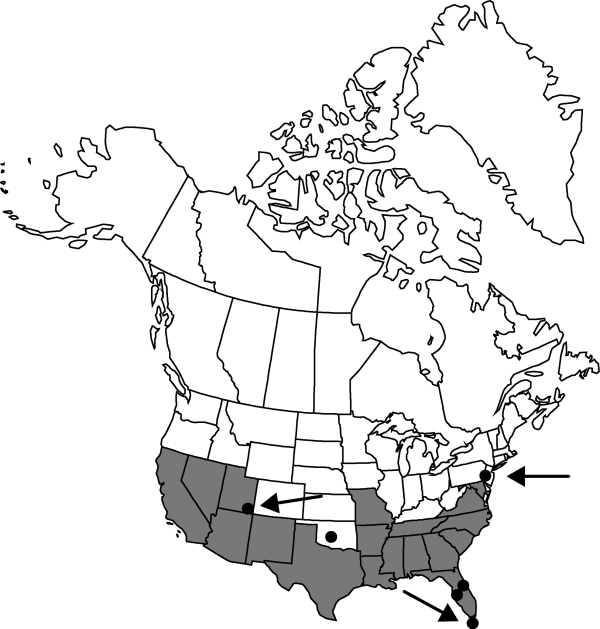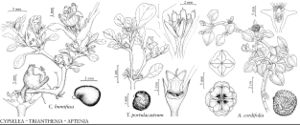Difference between revisions of "Trianthema portulacastrum"
Sp. Pl. 1: 223. 1753.
FNA>Volume Importer |
RevisionBot (talk | contribs) m (Bot: Adding category Revised Since Print) |
||
| (10 intermediate revisions by 3 users not shown) | |||
| Line 8: | Line 8: | ||
}} | }} | ||
|common_names=Desert horse-purslane | |common_names=Desert horse-purslane | ||
| + | |special_status={{Treatment/ID/Special_status | ||
| + | |code=F | ||
| + | |label=Illustrated | ||
| + | }} | ||
|basionyms= | |basionyms= | ||
|synonyms={{Treatment/ID/Synonym | |synonyms={{Treatment/ID/Synonym | ||
| − | |||
| − | |||
| − | |||
|name=Trianthema procumbens | |name=Trianthema procumbens | ||
|authority=Miller | |authority=Miller | ||
| + | |rank=species | ||
}} | }} | ||
|hierarchy=Aizoaceae;Trianthema;Trianthema portulacastrum | |hierarchy=Aizoaceae;Trianthema;Trianthema portulacastrum | ||
| Line 23: | Line 25: | ||
}}<!-- | }}<!-- | ||
| − | --><span class="statement" id="st- | + | --><span class="statement" id="st-undefined" data-properties=""><b>Plants </b>annual, succulent, usually glabrous. <b>Stems</b> prostrate or decumbent, diffusely branched, to 10 dm; young branches with lines of minute hairs proximal to petioles. <b>Leaves</b>: unequal pairs alternating along stem; stipules dilated at base; petiole usually equaling blade; blade elliptic to orbiculate, to 4 cm, apex obtuse, often notched, or apiculate. <b>Inflorescences</b>: flowers usually solitary, sessile, in axils of smaller leaves (bracts) of some pairs, partly covered by sheathing stipule of bracts; bracteoles connate, 1–1.5 mm, apex acute. <b>Flowers</b>: calyx 3–5 mm; calyx lobes purple adaxially, lanceolate, 2.5 mm; stamens 5–10. <b>Capsules</b> cylindric, ± curved, 4–5 mm, corky, basal portion appearing embedded in stem, apical portion containing 1 seed; apical wings 2, prominent, erect, crestlike. <b>Seeds</b> ca. 7, dull reddish brown to black, ridged, 1.5–2 mm.</span><!-- |
-->{{Treatment/Body | -->{{Treatment/Body | ||
| + | |phenology=Flowering spring–fall. | ||
|habitat=Moist or seasonally dry, usually open, wetlands including alkaline flats, playa lakes, banks of rivers, creeks, roadside depressions, beaches, disturbed areas including gardens, irrigated soils and ditches, fields, ballast, stockyards, sidewalks, railroad tracks | |habitat=Moist or seasonally dry, usually open, wetlands including alkaline flats, playa lakes, banks of rivers, creeks, roadside depressions, beaches, disturbed areas including gardens, irrigated soils and ditches, fields, ballast, stockyards, sidewalks, railroad tracks | ||
|elevation=0-1000 m | |elevation=0-1000 m | ||
|distribution=Ala.;Ariz.;Ark.;Calif.;Fla.;Ga.;La.;Md.;Miss.;Mo.;Nev.;N.J.;N.Mex.;N.C.;Okla.;S.C.;Tenn.;Tex.;Utah;Va.;Mexico;West Indies;Central America;South America;Africa. | |distribution=Ala.;Ariz.;Ark.;Calif.;Fla.;Ga.;La.;Md.;Miss.;Mo.;Nev.;N.J.;N.Mex.;N.C.;Okla.;S.C.;Tenn.;Tex.;Utah;Va.;Mexico;West Indies;Central America;South America;Africa. | ||
| − | |discussion=<p>In Arizona, Trianthema portulacastrum is a host plant of the beet leafhopper (T. H. Kearney and R. H. Peebles 1960). Seed dispersal is achieved by several methods: one seed is dispersed in the detached cap of the capsule, which can float, and the other seeds are either dispersed individually from the capsule or remain on the annual, parent plant where they will germinate and establish new plants where the parent once grew or was deposited.</p> | + | |discussion=<p>In Arizona, <i>Trianthema portulacastrum</i> is a host plant of the beet leafhopper (T. H. Kearney and R. H. Peebles 1960). Seed dispersal is achieved by several methods: one seed is dispersed in the detached cap of the capsule, which can float, and the other seeds are either dispersed individually from the capsule or remain on the annual, parent plant where they will germinate and establish new plants where the parent once grew or was deposited.</p> |
|tables= | |tables= | ||
|references= | |references= | ||
| Line 38: | Line 41: | ||
-->{{#Taxon: | -->{{#Taxon: | ||
name=Trianthema portulacastrum | name=Trianthema portulacastrum | ||
| − | |||
|authority=Linnaeus | |authority=Linnaeus | ||
|rank=species | |rank=species | ||
|parent rank=genus | |parent rank=genus | ||
| − | |synonyms= | + | |synonyms=Trianthema procumbens |
|basionyms= | |basionyms= | ||
|family=Aizoaceae | |family=Aizoaceae | ||
| + | |phenology=Flowering spring–fall. | ||
|habitat=Moist or seasonally dry, usually open, wetlands including alkaline flats, playa lakes, banks of rivers, creeks, roadside depressions, beaches, disturbed areas including gardens, irrigated soils and ditches, fields, ballast, stockyards, sidewalks, railroad tracks | |habitat=Moist or seasonally dry, usually open, wetlands including alkaline flats, playa lakes, banks of rivers, creeks, roadside depressions, beaches, disturbed areas including gardens, irrigated soils and ditches, fields, ballast, stockyards, sidewalks, railroad tracks | ||
|elevation=0-1000 m | |elevation=0-1000 m | ||
| Line 51: | Line 54: | ||
|publication title=Sp. Pl. | |publication title=Sp. Pl. | ||
|publication year=1753 | |publication year=1753 | ||
| − | |special status= | + | |special status=Illustrated |
| − | |source xml=https:// | + | |source xml=https://bitbucket.org/aafc-mbb/fna-data-curation/src/2e0870ddd59836b60bcf96646a41e87ea5a5943a/coarse_grained_fna_xml/V4/V4_171.xml |
|genus=Trianthema | |genus=Trianthema | ||
|species=Trianthema portulacastrum | |species=Trianthema portulacastrum | ||
| − | |||
| − | |||
| − | |||
| − | |||
| − | |||
| − | |||
| − | |||
| − | |||
| − | |||
| − | |||
| − | |||
| − | |||
| − | |||
| − | |||
| − | |||
| − | |||
| − | |||
| − | |||
| − | |||
| − | |||
| − | |||
| − | |||
| − | |||
| − | |||
| − | |||
| − | |||
| − | |||
| − | |||
| − | |||
| − | |||
| − | |||
| − | |||
| − | |||
| − | |||
| − | |||
| − | |||
| − | |||
| − | |||
| − | |||
| − | |||
}}<!-- | }}<!-- | ||
| − | -->[[Category:Treatment]][[Category:Trianthema]] | + | --> |
| + | |||
| + | [[Category:Treatment]] | ||
| + | [[Category:Trianthema]] | ||
| + | [[Category:Revised Since Print]] | ||
Latest revision as of 20:37, 6 November 2020
Plants annual, succulent, usually glabrous. Stems prostrate or decumbent, diffusely branched, to 10 dm; young branches with lines of minute hairs proximal to petioles. Leaves: unequal pairs alternating along stem; stipules dilated at base; petiole usually equaling blade; blade elliptic to orbiculate, to 4 cm, apex obtuse, often notched, or apiculate. Inflorescences: flowers usually solitary, sessile, in axils of smaller leaves (bracts) of some pairs, partly covered by sheathing stipule of bracts; bracteoles connate, 1–1.5 mm, apex acute. Flowers: calyx 3–5 mm; calyx lobes purple adaxially, lanceolate, 2.5 mm; stamens 5–10. Capsules cylindric, ± curved, 4–5 mm, corky, basal portion appearing embedded in stem, apical portion containing 1 seed; apical wings 2, prominent, erect, crestlike. Seeds ca. 7, dull reddish brown to black, ridged, 1.5–2 mm.
Phenology: Flowering spring–fall.
Habitat: Moist or seasonally dry, usually open, wetlands including alkaline flats, playa lakes, banks of rivers, creeks, roadside depressions, beaches, disturbed areas including gardens, irrigated soils and ditches, fields, ballast, stockyards, sidewalks, railroad tracks
Elevation: 0-1000 m
Distribution

Ala., Ariz., Ark., Calif., Fla., Ga., La., Md., Miss., Mo., Nev., N.J., N.Mex., N.C., Okla., S.C., Tenn., Tex., Utah, Va., Mexico, West Indies, Central America, South America, Africa.
Discussion
In Arizona, Trianthema portulacastrum is a host plant of the beet leafhopper (T. H. Kearney and R. H. Peebles 1960). Seed dispersal is achieved by several methods: one seed is dispersed in the detached cap of the capsule, which can float, and the other seeds are either dispersed individually from the capsule or remain on the annual, parent plant where they will germinate and establish new plants where the parent once grew or was deposited.
Selected References
None.
